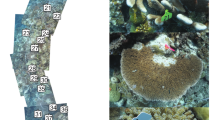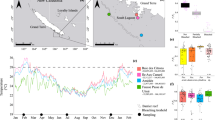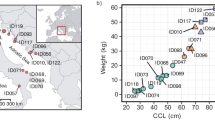Abstract
It is widely reported that coral reefs are suffering degradation from a combination of stresses. We have previously reported the use of genomic tools in the study of environmental impact assessment and hypothesize that monitoring the bacterial diversity associated with a coral would indicate changes in its health before visible damage occurs. This study analyzes the bacterial diversity associated with Porites coral collected from two sites in the Arabian Sea using culture independent techniques. Two clone libraries were constructed from the16S rDNA amplicons and selected individual clones were partially sequenced. Retrieved sequences were identified by BLAST analysis and indicate the presence of unidentified bacteria. Diversity index was calculated using Shannon–Wiener index. The bacterial diversity associated with coral sample 1 gives the index of species diversity, H 1 as 1.6287, divergence from eqiprobability as 45.708% and the evenness of the sample as 54.291. For coral sample 2, the values obtained were, H 1 as 1.97, divergence from eqiprobability as 15.11% and the evenness of the sample as 84.88. Sequences representing bacteria related to agricultural or industrial pollution and pathogenesis were also found. Coral samples collected near a lagoon area, showed a greater percentage of sequences representing bacteria related to human interventions, indicative of pollution.





Similar content being viewed by others
References
Abbondanzi F, Campisi T, Focanti M et al (2005) Assessing degradation capability of aerobic indigenous microflora in PAH-contaminated brackish sediments. Mar Environ Res 59:419–434
Abraham WR, Strompl C, Meyer H et al (1999) Phylogeny and polyphasic taxonomy of Caulobacter species Proposal of Maricaulis gen nov with Maricaulis maris (Poindexter) comb nov as the type species, and emended description of the genera Brevundimonas and Caulobacter. Int J Syst Bacteriol 49:1053–73
Aguilar A, Borrell A (2005) DDT and PCB reduction in the western Mediterranean from 1987 to 2002, as shown by levels in striped dolphins (Stenella coeruleoalba). Mar Environ Res 59:391–404
Akay M, Gunduz E, Gulbas Z (2006) Catheter-related bacteremia due to chryseobacterium indologenes in a bone marrow transplant recipient. Bone Marrow Transpl PMID:16415896 37:435–436
Bernardet JF, Vancanneyt M, Matte-Tailliez O et al (2005) Polyphasic study of Chryseobacterium strains isolated from diseased aquatic animals. Syst Appl Microbiol 28:640–660
Bourne DG, Munn CB (2005) Diversity of bacteria associated with the coral Pocillopora damicornis from the Great Barrier Reef. Environ Microbiol 7:1162–1174
Dobretsov S, Qian P-Y (2004) The role of epibiotic bacteria from the surface of the soft coral Dendronephthya sp in the inhibition of larval settlement. J Exp Mar Biol Ecol 299:35–50
Ducklow HW, Mitchell R (1979) Bacterial populations and adaptations in the mucus layers on living corals. Limnol Oceanogr 24:715–725
Fabricius KE (2005) Effects of terrestrial runoff on the ecology of corals and coral reefs: review and synthesis. Mar Pollut Bull 50:125–146
Fent K (1989) Organotin speciation in municipal wastewater and sewage sludge: Ecotoxicological consequences. Mar Environ Res 28:477–483
Fuhrman JA, Campbell L (1998) Microbial microdiversity. Nature 393:410–411
Hewson I, Fuhrman JA (2006) Improved strategy for comparing microbial assemblage fingerprints. Microbial Ecol PMID: 16437287 5:147–153
Kapley A, Lampel K, Purohit HJ (2000) Development of duplex PCR for Salmonella and Vibrio. World J Microbiol Biotechnol 16:457–58
Kumar M, Philip L (2006) Enrichment and isolation of a mixed bacterial culture for complete mineralization of endosulfan. J Environ Sci Heal B 41:81–96
Lewis JB, Price WS (1975) Feeding mechanisms and feeding strategies of Atlantic reef corals. J Zool 176:527–544
Martin M, Mengs G, Allende JL et al (1999) Characterization of two novel propachlor degradation pathways in two species of soil bacteria. Appl Environ Microb 65:802–806
Narde G, Kapley A, Purohit HJ (2004) Isolation and characterization of Citrobacter strain HPC 255 for broad range substrate specificity for chlorophenol. Curr Microbiol 48:419–423
Pace NR (1997) A molecular view of microbial diversity and the biosphere. Science 276:734–740
Pantos O, Cooney RP, Le Tissier MDA (2003) The bacterial ecology of plaque-like disease affecting the Caribbean coral Montastrea annularis. Environ Microbiol 5:370–382
Paster BJ, Boches SK, Galvin JL et al (2001) Bacterial diversity in human subgingival plaque. J Bacteriol 183:3770–3783
Purohit HJ, Raje DV, Kapley A et al (2003) Genomics tools in environmental impact assessment. Environ Sci Technol 37:356A–363A
Richardson LL (1998) Coral diseases: what is really known? Trends Ecol Evol 13:438–443
Ritchie KB, Smith GW (1995) Preferential carbon utilization by surface bacterial communities from water mass, normal and white band diseased Acropora cervicornis. Mol Mar Biol Biotech 4:345–354
Ritchie KB, Smith GW (2004) Coral health and disease. Springer-Verlag, New York
Rohwer F, Breitbart M, Jara J et al (2001) Diversity of bacteria associated with the Caribbean coral Montastraea franksi. Coral Reefs 20:85–91
Shannon CE (1948) A mathematical theory of communication. Bell Syst Tech J 27:379–423
Takami H, Kobata K, Nagahama T et al (1999) Biodiversity in deep-sea sites located near the south part of Japan. Extremophiles 3:97–102
Tilman D, Fargione J, Wolff B et al (2001) Forecasting agriculturally driven global environmental change. Science 292:281–284
Thompson JD, Gibson TJ, Plewniak F et al (1997) The ClustalX windows interface: flexible strategies for multiple sequence alignment aided by quality analysis tools. Nucleic Acids Res 25:4876–4882
Vitousek PM, Aber JD, Howarth RW (1997) Human alteration of the global nitrogen cycle: sources and consequences. Ecol Appl 7:737–750
Acknowledgments
This study was supported by a grant from the Council of Scientific And Industrial Research, India, project SMMOOO2.
Author information
Authors and Affiliations
Corresponding author
Rights and permissions
About this article
Cite this article
Kapley, A., Siddiqui, S., Misra, K. et al. Preliminary analysis of bacterial diversity associated with the Porites coral from the Arabian sea. World J Microbiol Biotechnol 23, 923–930 (2007). https://doi.org/10.1007/s11274-006-9315-1
Received:
Accepted:
Published:
Issue Date:
DOI: https://doi.org/10.1007/s11274-006-9315-1




